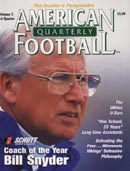Article CategoriesAFM Magazine
|
BalanceUsing The Triangle Principle For A Balanced Offenseby: Bill Cubit Offensive Coordinator, Western Michigan University © More from this issue Our basic offensive philosophy at Western Michigan is to remain as balanced and unpredictable as possible, by incorporating the run from a variety of looks (i.e., different combination of personnel, shifting, and motion) in as many different strategic situations as possible. Our balance is achieved by the percentage of run/pass relative to repititions, not yardage. As a result, we have a system that is flexible, simple to learn, and easily adapted to our personnel. The quarterback is taught to learn in triangles where three receivers will be operating in an area in which one to two defenders dictate the decision process. Our Under and Cross series enable us to use a fairly extensive package with basic rules for our receivers. Basic rules for our receivers are as follows: 1. The called receiver will run an under route. If a cross route is called, the called receiver will still run an under route. 2. If the called receiver is on the outside, the receiver immediately inside will run a corner route (get a smash/cor- ner combination). 3. If a cross route is called, the receiver inside-opposite will run the dig. 4. If an under route is called, the receiver inside-opposite will run the dig route. 5. If no rule applies, then the receiver will run a go route (i.e., if the receiver is outside of an under or cross route). 6. B Back &- If the under or cross is coming from the outside, the B-Back will run away from the route. If the under or cross route is coming from an inside receiver, the B Back will run to the route. 7. Z &- If Z under or Z cross is called, the Z will never continue towards the formation unless the defense is in man coverage. We can run multiple formations and numerous combinations of routes with different personnel and groupings. Our system is adaptable in isolating areas of the field by using the Triangle Principle. Additionally, it is important to read the drops of the linebackers and safeties. In X and Z Under or Cross, the quarterback reads are the same in Cover 3 or a soft corner. The quarterback will take a quick five-step drop and throw to the Under route. If there is a sit/corner route combination, the quarterback will look to his triangles, reading the depth of the linebacker drops and robber coverage by the secondary. In T and Y Under or Cross, the quarterback will take a long five-step drop and read the linebacker drops and robber coverage by the secondary. We will always try to get the Dig Route over the ball to correspond with the Under routes and the B &- Back routes. This will create a triangle effect and give the quarterback simple reads over the ball. The eight plays diagramed here are our base pass offensive schemes that help us to effectively utilize the powerful triangle principle. Refer to the text within each diagram for specific and unique rules and tips. No matter if you run an offense based on four formations or 40, obviously it is important to be able to teach the basic concepts and principles of your offense as unilaterally as possible. The Triangle Principle is a valuable tool that enables quick and effective teaching of our basic concepts to each and every one of our offensive skill players. Quarterback Calls, Balanced Run/Pass Ratio Critical 1998, the third year of Gary Darnell's tenure at Western Michigan, proved to be another in which Bill Cubit's offense showed its worth, claiming several school records and approaching some Mid-American Conference marks in the meantime. The Broncos, 2-9 in 1996 and 8-3 in 1997, posted a 7-4 record in 1998. The exciting brand of offense the staff brought to Kalamazoo has been instrumental in brining much more than wins to town, as the two-hour radius presents fans opportunities to devote their loyalties to Michigan, Michigan State or Notre Dame. The mostly one-back, decision-making quarterback-driven offense also endears Kalamazoo to more-and-more recruits, as the Broncos won a handful of recrutiting wars this winter over more high-profile programs. Cubit's offense, with Tim Lester at quarterback in 1998, was 12th in NCAA I-A (467.9 yards per game) in total offense, 9th in passing offense (310.4 ypg) and 20th in scoring offense (32.7 points per game). As expected, experience was a factor in a offense that puts intense pressure on the quarterback to put the team in the right play and will utilize seven worker-type receivers on any given Saturday. "We put a lot of freedom and pressure in the QB position," said Cubit. "We teach them to read defenses and where to attack them before we actually teach them plays. Teaching the quarterback where you want the football . . . that's what we try to do." Obviously, the WMU staff was able to do that in 1998. Though turnovers were still part of the learning curve (16 INTs thrown vs. 22 TDs, 12 lost fumbles), Cubit feels the players are getting a good feel for the system, an offense where the staff emphasizes a desire to maintain a 1:1 run/pass ratio. He says the hardest part of the offense is probably calling checks into the running game, especially considering that the Broncos called plays from 42 different formations last season. "In this scheme, the quarterback has to be real sharp. We expect the QB to be about 95 percent accurate on his run checks. Tim was almost there," Cubit said. |
|
| HOME |
MAGAZINE |
SUBSCRIBE | ONLINE COLUMNISTS | COACHING VIDEOS |
Copyright 2024, AmericanFootballMonthly.com
All Rights Reserved




